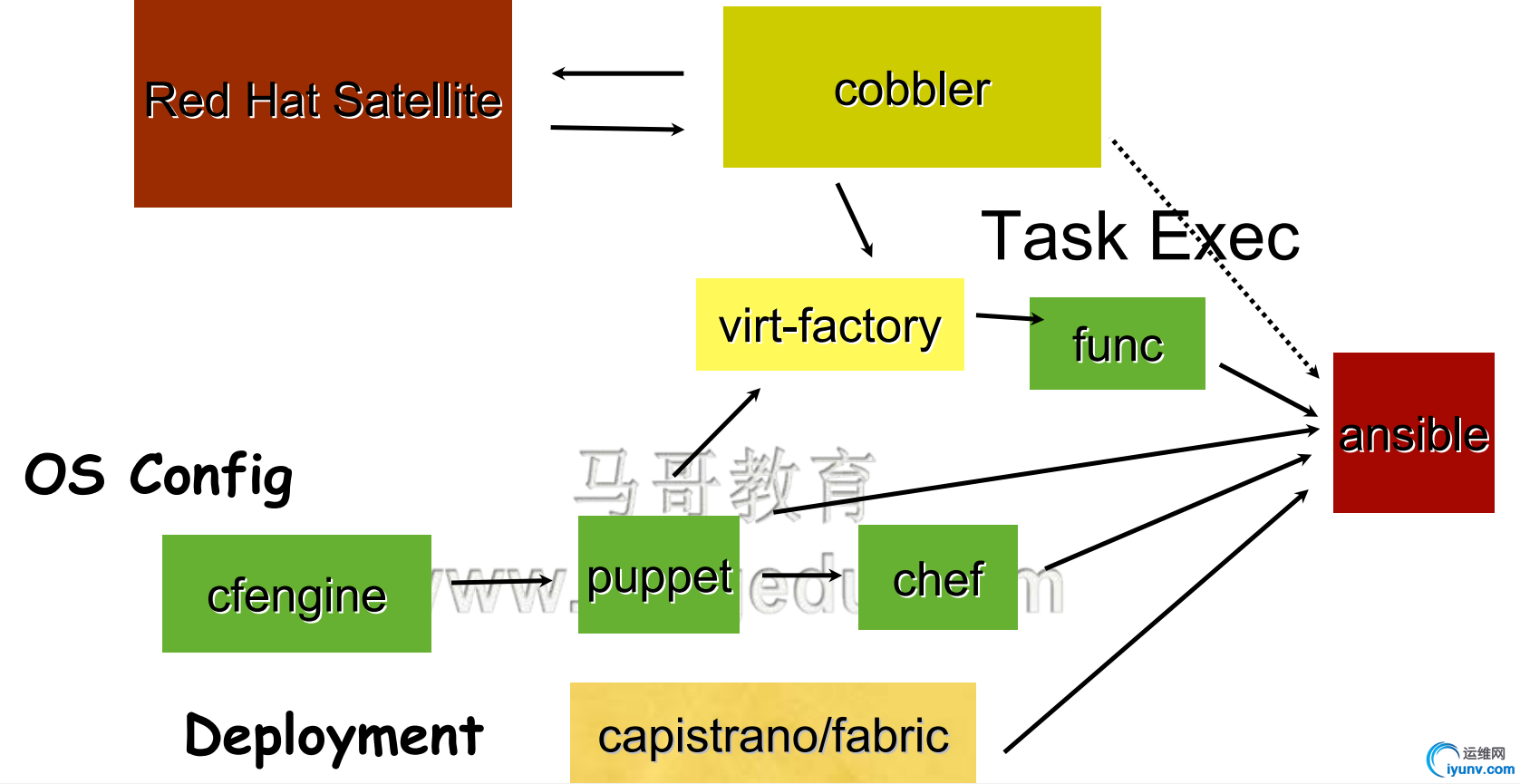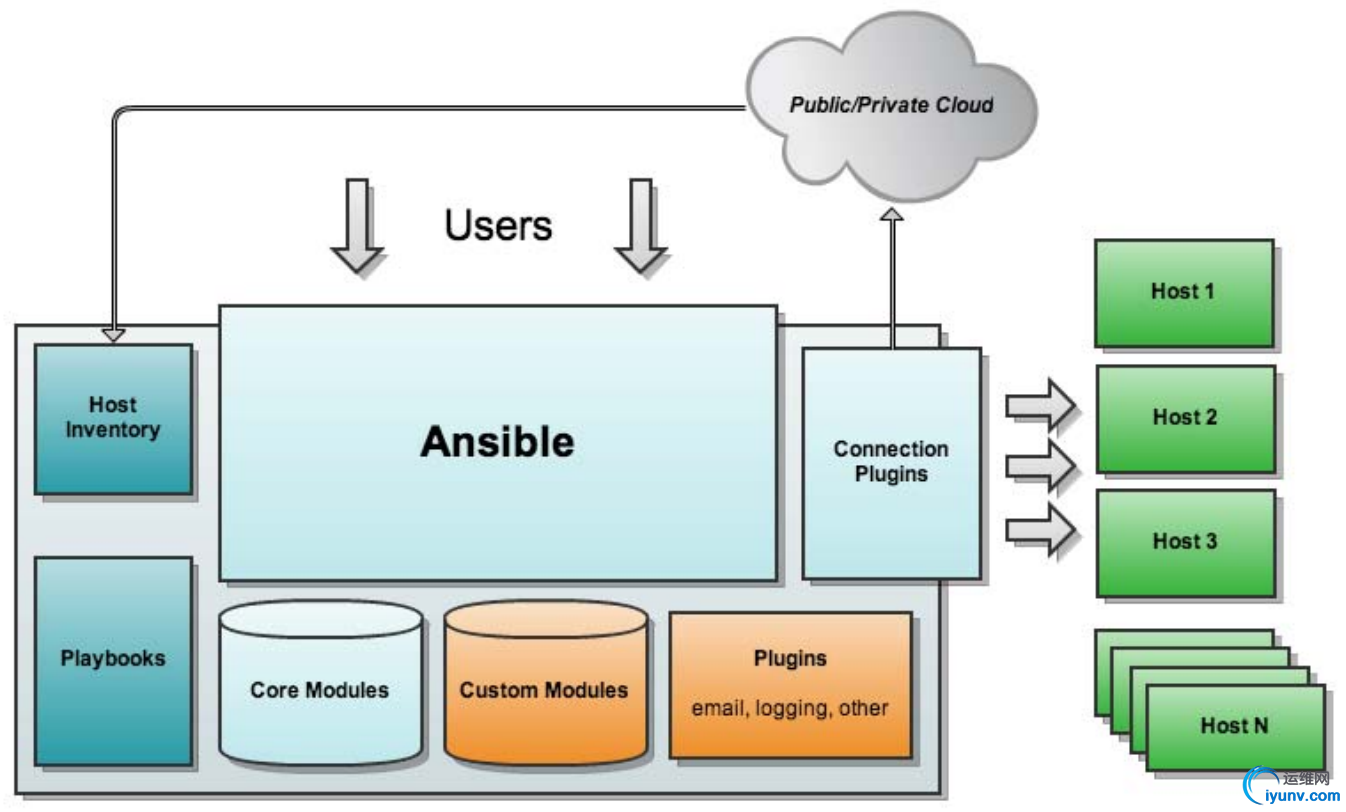一、常见的自动化运维工具:
OS Provisioning:PXE, Cobbler OS Config:puppet, saltstack, chef, func Task Exec:fabric, saltstack, func Program Deployment:fabric 管理主机控制被管理节点的方式: agent:被管理节点上需要安装代理程序以接受管理主机的操作;如puppet, func agentless:被管理节点不需安装代理程序,管理主机借助ssh传递操作指令,如ansible, fabric;
二、ansible介绍

ansible是一款基于python开发,揉合了众多自动化运维工具功能的轻量级自动化运维工具,目前实现了除系统安装以外的批量系统配置、批量任务执行及批量程序部署等功能。
1、ansibler的架构

⑴ansible核心程序
⑵connection plugins:连接插件,负责和被控制端通信;
⑶host inventory:主机库,定义可控制的主机;
⑷modules:core modules、custom modules
⑸playbook:剧本,使用YAML编写的声明性的配置文件
⑹plugins:各种插件,完成日志记录、邮件等功能;
ansible从host inventory中获取被控制的主机信息,通过connection plugins连接主机,调用指指定模块向被控制端发送操作指令。
2、ansible的特性
⑴高度模块化,借助模块完成各种任务
⑵agentless,即无需在被控制端安装agent
⑶默认基于ssh协议向被控制端发送操作指令
①基于密钥认证
②在inventory文件中指定账号和密码
⑷一系列任务执行可写成剧本(playbook)
⑸具有幂等性:不会重复执行相同操作,比如不会重复安装软件
三、ansible安装配置
以下node1为ansible主机,node2、node3、node4为被控制主机
1、rpm安装(epel源)
yum -y install ansible #只需要在控制端安装
主配置文件:/etc/ansible/ansible.cfg
inventory:/etc/ansible/hosts
1
2
3
4
5
6
7
8
9
10
11
12
13
14
15
16
17
18
19
20
21
22
23
24
25
26
27
28
29
30
31
32
33
34
35
36
37
38
39
40
41
42
43
44
45
46
| [iyunv@node1 ~]# yum -y install ansible
Installed:
ansible.noarch 0:1.9.4-1.el6
Dependency Installed:
PyYAML.x86_64 0:3.10-3.1.el6 libyaml.x86_64 0:0.1.3-4.el6_6 python-babel.noarch 0:0.9.4-5.1.el6 python-crypto2.6.x86_64 0:2.6.1-2.el6
python-httplib2.noarch 0:0.7.7-1.el6 python-jinja2.x86_64 0:2.2.1-2.el6_5 python-keyczar.noarch 0:0.71c-1.el6 python-pyasn1.noarch 0:0.0.12a-1.el6
python-setuptools.noarch 0:0.6.10-3.el6 python-simplejson.x86_64 0:2.0.9-3.1.el6 sshpass.x86_64 0:1.05-1.el6
Complete!
[iyunv@node1 ~]# rpm -ql ansible | less
/etc/ansible
/etc/ansible/ansible.cfg #主配置文件
/etc/ansible/hosts #host inventory
/etc/ansible/roles
/usr/bin/ansible #主程序
/usr/bin/ansible-doc #获取帮助信息
/usr/bin/ansible-galaxy
/usr/bin/ansible-playbook #运行“剧本”的命令
/usr/bin/ansible-pull
/usr/bin/ansible-vault #可把playbook加密存放
/usr/lib/python2.6/site-packages/ansible
...
[iyunv@node1 ~]# vim /etc/ansible/ansible.cfg
...
[defaults]
# some basic default values...
inventory = /etc/ansible/hosts #inventory文件路径
#library = /usr/share/my_modules/
remote_tmp = $HOME/.ansible/tmp
pattern = *
forks = 5 #执行任务时启动的并发线程数
poll_interval = 15
sudo_user = root
#ask_sudo_pass = True
#ask_pass = True
transport = smart
#remote_port = 22 #远程被控节点的ssh端口
module_lang = C
...
...
|
2、添加被控制主机
vim /etc/ansible/hosts
ntp.iyunv.com #不属于任何组的主机直接定义在文件中最上端
[websrvs] #可将一批主机归于一个组
www1.iyunv.com:2222 #若被控节点的ssh使用了非默认端口,可以在被控节点后标明
www2.iyunv.com
www[01:50].example.com #可使用通配
172.16.100.7
[dbsrvs]
db-[a:f].example.com
◆默认以root用户身份执行,如果是口令认证,则需要在任务执行时输入密码或在inventory中的被控制主机旁以参数的形式指明,例如:
192.168.30.20 ansible_ssh_user=fedora ansible_ssh_pass=magedu
192.168.30.13 ansible_ssh_pass=magedu [ansible_ssh_port=2222]
基于口令认证当然比较麻烦,故通常配置ssh基于密钥认证
inventory中还有一些可配置的参数,具体见官方文档
◆主机变量
可以在inventory中定义主机时为其添加主机变量。例如:
[websrvs]
www1.iyunv.com http_port=80 maxRequestsPerChild=808
www2.iyunv.com http_port=8080 maxRequestsPerChild=909
◆组变量
组变量是指赋予给指定组内所有主机上的变量。例如:
[websrvs]
www1.iyunv.com
www2.iyunv.com
[websrvs:vars]
ntp_server=ntp.iyunv.com
nfs_server=nfs.iyunv.com
◆组嵌套
inventory中,组还可以包含其它的组,并且也可以向组中的主机指定变量。例如:
[apache]
httpd1.iyunv.com
httpd2.iyunv.com
[nginx]
ngx1.iyunv.com
ngx2.iyunv.com
[websrvs:children]
apache
nginx
[websrvs:vars]
ntp_server=ntp.iyunv.com
注意:在inventory文件中定义的变量只能在playbook中使用,而ansible命令不支持
1
2
3
4
5
6
7
8
9
10
11
12
13
14
15
16
17
18
19
20
21
22
23
24
25
26
27
28
29
30
31
32
33
| [iyunv@node1 ~]# cd /etc/ansible/
[iyunv@node1 ansible]# vim hosts #inventory文件中有些配置示例,可参考
....
# Ex 1: Ungrouped hosts, specify before any group headers.
## green.example.com #可以是主机名
## blue.example.com
## 192.168.100.1 #也可是ip地址
## 192.168.100.10
# Ex 2: A collection of hosts belonging to the 'webservers' group
## [webservers]
## alpha.example.org
## beta.example.org
## 192.168.1.100
## 192.168.1.110
# If you have multiple hosts following a pattern you can specify
# them like this:
## www[001:006].example.com
# Ex 3: A collection of database servers in the 'dbservers' group
## [dbservers]
##
## db01.intranet.mydomain.net
## db02.intranet.mydomain.net
## 10.25.1.56
## 10.25.1.57
...
[iyunv@node1 ansible]# cp hosts hosts.bac
|
3、配置ssh基于密钥认证
ssh-keygen -t rsa
ssh-copy-id -i .ssh/id_rsa.pub root@192.168.30.20
4、ansible的几个命令:
⑴ansible-doc
ansible-doc -l:列出所有模块
ansible-doc [-s] MODULE_NAME:查看指定模块的用法
-s:生成可以复制到playbook中以作修改的摘要;简而言之就是以简要形式显示模块用法
常用模块:command, user, copy, cron, file, filesystem, group, hostname, ping, yum
service, shell, script
command模块并不支持shell变量和管道等,若想使用shell来执行,应调用shell模块
⑵ansible:执行任务
ansible [-f forks][-m module_name] [-a args] [options]
-m module_name:指定调用的模块
-a args:指定向模块传递的参数
-f #:指定并发数
-k:默认基于密钥认证,使用该选项指定基于口令认证
◆host-pattern:
all, * #所有主机
192.168.30.20, 192.168.30.*
www.example.com, www.example.com:ftp.test.com
websrvs #组中的所有主机
websrvs:dbsrvs #两个组中的所有主机
websrvs:!dbsrvs #在websrvs不在dbsrvs的主机
websrvs:&dbsrvs #同时在websrvs和dbsrvs中的主机
5、ansible常用模块及其使用示例
①command:命令模块,默认模块,用于在远程执行命令;command模块并不支持shell变量和管道等,若想使用shell执行复杂命令,应调用shell模块
例:ansible [-m command] all -a 'date'
②cron:周期性任务计划模块
state:
present:生成
absent:移除
例:ansible websrvs -m cron -a 'name="sync time" minute="*/3" job="/usr/sbin/ntpdate 172.16.100.1 &> /dev/null"'
③user:管理用户
例:ansible websrvs -m user -a 'name=fedora password=加密串'
④copy:复制文件
src=:指定本地源文件路径
content=:取代src=,表示直接用此处指定的内容生成为目标文件内容
dest:指定远程目标文件路径
例:ansible websrvs -m copy -a 'src=/mine/ntp.conf dest=/etc/ntp.conf[ owner=root group=root mode=644 backup=yes]'
ansible websrvs -m copy -a 'content="hello" dest=/tmp/test.ansible' ⑤file:设定文件属性 path=:指定文件路径,可换成name或dest 创建符号链接: src=:指明源文件 path=:指明符号链接文件路径 例:ansible websrvs -m file -a 'src=/tmp/test.ansible path=/tmp/test.link state=link'
ansible websrvs -m file -a 'owner=fedra group=fedra mode=644 path=/tmp/test.ansible' ⑥service:控制服务的运行状态 enabled=:是否开机自动启动,取值为true或false state=:状态,取值有started, stopped, restarted 例:ansible websrvs -m service -a 'name=httpd state=started enabled=true' ⑦shell: ansible websrvs -m shell -a 'echo $TERM' ⑧script:将本地脚本复制到远程主机并运行 例:ansible websrvs -m script '/root/adduser.sh' ⑨ping:测试指定主机是否能连接 ⑩yum:管理程序包 name=:指明要安装或卸载的程序包,可带上版本号 state:present,latest表示安装;absent表示卸载 例:ansible all -m yum -a 'name=zsh' ansible all -m yum -a 'name=zsh state=absent' ⑾setup:收集远程主机的facs 每个被管理节点在接收并运行管理命令之前,会将本主机相关信息,如操作系统版本,ip地址,cpu数量等报告给ansible主机 其它模块:filesystem, group, hostname等
|